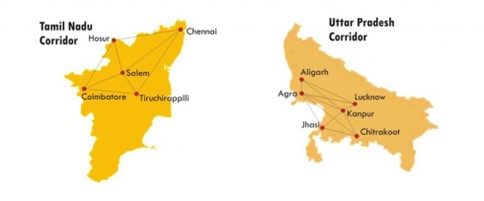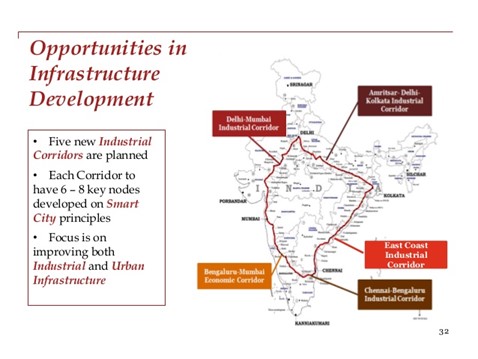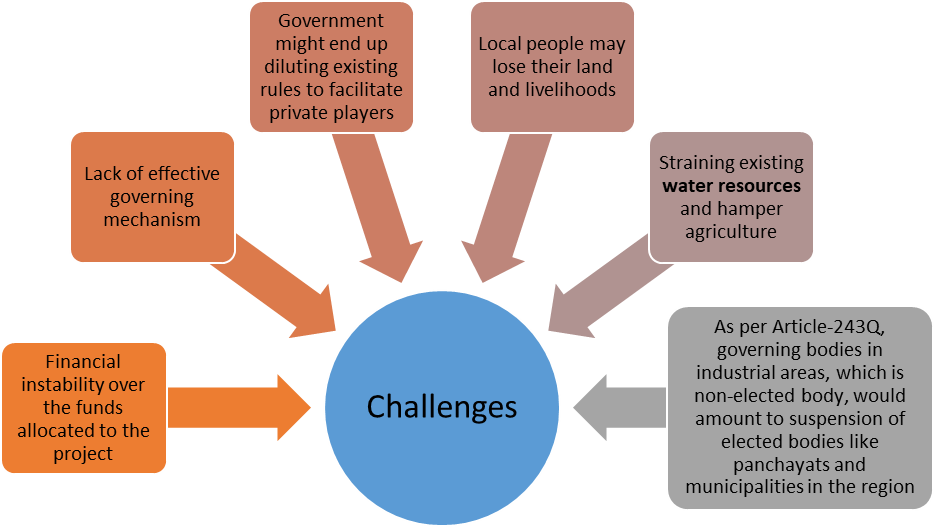PREVIOUS
Industrial Corridors of Tamil Nadu
May 2 , 2023
948 days
26007
0
Please click here tamil version for this article
- An industrial corridor is basically a corridor comprising of multi-modal transport services that would pass through the states as main artery.
- It is a package of infrastructure spending allocated to a specific geographical area, with the intent to stimulate industrial development.
- It aims to create an area with a cluster of manufacturing or another industry.
- It offers effective integration between industry and infrastructure
- It is leading to overall economic and social development.
- Industrial corridors constitute world-class infrastructure, such as: High-speed transportation network – rail and road.

Industrial Corridors of Tamil Nadu
Chennai–Kanyakumari Industrial Corridor (CKIC)
- The Chennai-Kanyakumari Industrial Corridor is part of India’s East Coast Economic Corridor (ECEC).
- It stretches from West Bengal to Tamil Nadu and connects India to the production networks of South, Southeast, and East Asia.
- The Asian Development Bank (ADB) will be providing a $484 million loan (over Rs 3,500 crore) to improve transport connectivity and facilitate industrial development in the Chennai-Kanyakumari Industrial Corridor (CKIC) in Tamil Nadu.
- The funding will be used for a project to upgrade about 590 kilometers of state highways.
- The ADB is the lead partner of the Indian government in developing the ECEC.
- It aims to unlock the potential to accelerate manufacturing growth in the state of Tamil Nadu.

- Tamil Nadu already ranks high in India in terms of economic prowess, and is one of the most competitive across several key indicators.
- It influences area covers 23 of the 32 districts of Tamil Nadu, which accounts for 74% of the state’s population and 67% of its output.
- The region has a developed industrial ecosystem in key sectors such as automobiles and textiles.
- It has 3 major ports and 2 minor ports with combined cargo of 240 million tonnes per year.
- CKIC and its infrastructure plan will be aligned with Vision 2023 of the Government of Tamil Nadu and the Sagarmala initiative with initial focus on the southern region.
The Six nodes of CKIC
- Cuddalore and Nagapattinam
- Ariyalur and Perambalur
- Trichy-Pudukkottai-Sivagangai
- Madurai-Virudhunagar-Dindigul-Theni (MVDT)
- Ramanathapuram (NIMZ) and
- Thoothukudi and Tirunelveli (TT)
Chennai Bengaluru Industrial Corridor (CBIC)
- It is one of the five industrial corridors coming up in India under the aegis of National Industrial Corridor Development and Implementation Trust (NICDIT)
- These projects have been planned on the backbone of multi modal connectivity infrastructure.
- Three nodes namely Tumakuru in Karnataka, Krishnapatnam in Andhra Pradesh and Ponneri in Tamil Nadu have been identified for development under CBIC.
- Krishnapatnam Industrial Area in Andhra Pradesh and Tumakuru Industrial Area in Karnataka under Chennai Bengaluru Industrial Corridor (CBIC) have been approved to kick start the development in Chennai Bengaluru Industrial Corridor Project.
- Krishnapatnam Industrial Area, Andhra Pradesh - Total Area, 11098 acre (3 phase development)
- Tumakuru Industrial Area, Karnataka - Total Area, 8484 acre (3 phase development) - Changed Phase-1 area to 1722 acre.
- The corridor plans are to come up along Chennai, Sriperumbudur, Ponnapanthangal, Ranipet, Suburbans of Vellore, Chittoor, Bangarupalem, Palamaner,Bangarpet, Hoskote and Bangalore
- It is expected to boost commerce between south India and east Asia by enabling quicker movement of goods from these places to the Chennai and Ennore ports.
- Recently it has been planned to be extended to Coimbatore city of Tamil Nadu and Kochi city of Kerala.
- The project with assistance from the Japan International Cooperation Agency (JICA) will be developed in collaboration with the governments of three southern states.
- These greenfield industrial cities will be self-sustained with world-class infrastructure, road and rail connectivity for freight movement to and from ports and logistic hubs along with reliable power and quality social infrastructure.
- The strategy to develop CBIC is part of the plan to achieve accelerated development, regional industry agglomeration in the states of Tamil Nadu, Karnataka and Andhra Pradesh.

- It facilitates development of a well-planned and efficient industrial base by providing smooth access to the industrial production units, decreased transportation logistics costs along with an improved delivery time and reduction in inventory cost.
- It ensures increased private investments in manufacturing and industrial activity in the three states.
- Above Industrial Corridors are at different stages of implementation.
- Out of three nodes to be developed in CBIC, land has been made available in two nodes, - Krishnapatnam and Tumakuru.
- These are scheduled to be developed by 2026.
- For other corridors/nodes, since project development activities are going on, the timelines can be ascertained after availability of land and competent approval.
Defence Industrial Corridor
- A defence corridor refers to a route or a path along which domestic productions of defence equipment by public sector, private sector and MSMEs are lined up to enhance the operational capability of the defence forces.

- It will catalyse indigenous production of defence and aerospace-related items.
- It will reduce our imports and promote the export of these items to other countries.
- To achieve Aatmanirbharta and realise the goal of 'Make in India', Government of India has established two Defence Industrial Corridors (DICs) in the country, one in Uttar Pradesh and other in Tamil Nadu.
- It will create economies of scale and facilitate development of internationally competitive enterprises in the country.
Tamil Nadu Defence Industrial Corridor
- The corridor was inaugurated in 2019.
- The Tamil Nadu Defence Corridor, being set up by the Government of Tamil Nadu, consists of the following five nodal points:
- Chennai
- Coimbatore
- Hosur
- Salem
- Tiruchirappalli

- It aims to make Tamil Nadu Defence Corridor as a global defence manufacturing destination to invest, innovate and create products and services catering to the Aerospace and Defence industry.
- It will create new defence production facilities and promote clusters with necessary testing and certification facilities, export facilitation centres, technology transfer facilitation, etc.
- It will aid in the nation's military production self-sufficiency and the promotion of 'Make in India,' which will cut imports and boost the export of these commodities to other countries.
- It would boost the defence manufacturing ecosystem by promoting the expansion of private domestic manufacturers, especially MSMEs and start-ups, through synergistic technology development.
- The State holds the following strategic advantages which makes it a suitable destination for a defence corridor:
- The large coastal line which has four large seaports (three government and one private) and 22 minor ports.
- The state has four international airports at Chennai, Coimbatore, Trichy, Madurai; and two domestic airports at Tuticorin and Salem.
- A power surplus state with renewable energy capacity of 11,113 MW.
- Tamil Nadu’s capital city Chennai is connected to the world by three submarine cables providing a bandwidth of 14.8 Tbps.
- A destination of choice for Korean investors; the state is the largest Recipient of Korean Foreign Direct Investment (FDI) to India.
Characteristics of industrial corridors
Geographical Focus
- Industrial corridors are geographically concentrated areas with well-defined boundaries.
- The focus is on developing the existing infrastructure in a region, such as transportation, power, and water supply.
Integrated Planning
- Industrial corridors are developed through integrated planning, involving multiple stakeholders such as government agencies, private investors, and local communities.
- The planning process includes the identification of suitable locations, infrastructure requirements, and policy frameworks.
Multi-Modal Transport System
- Industrial corridors are well connected through multi-modal transport systems such as highways, railways, ports, and airports.
- This connectivity is crucial for the efficient movement of goods and people, reducing logistics costs, and improving competitiveness.
Clusters of Industries
- Industrial corridors consist of clusters of industries that are interconnected, sharing common resources and services such as electricity, water, and waste management.
- The clustering of industries leads to economies of scale, enhances productivity, and fosters innovation.
Greenfield Development
- Industrial corridors are often developed on greenfield sites, allowing for the creation of new infrastructure and facilities.
- This greenfield development ensures that the infrastructure is designed to meet the needs of modern industries and is not constrained by existing infrastructure.
Special Economic Zones (SEZs)
- Industrial corridors often include special economic zones (SEZs), which offer tax incentives, streamlined regulations, and other benefits to attract foreign and domestic investments.
- SEZs are designed to promote exports, increase employment, and enhance economic growth.
Benefits of Industrial Corridor
Economic Benefits
- This will help build logistics infrastructure that will aid in firms achieve economies of scale and help them focus on their core competencies.
- This will provide a huge impetus to employment generation and has the potential to reverse distress migration.

- This can promote exports by way of lowering logistics costs and improving the efficiency of business units.
- This will enhance private sector investments.
- The manufacturing and the infrastructure sector will see a huge improvement in the country which will contribute to the GDP, and lead to overall economic prosperity.
Environmental Benefits
- The development of industries in a scattered manner along various routes will prevent the concentration of industrial units in a few places.
- This will prevent environmental exploitation and degradation.

Socioeconomic Benefits
- Industrial corridors will have a cascading effect on the cities and towns along their routes.

- Apart from the development of small towns as smart cities, this will also see a flourishing of other amenities such as hospitals, educational institutions, etc.
- This will benefit the people living there immensely.
- Such corridors will have world-class facilities such as high-speed road and rail transportation networks, ports with modern cargo handling systems, modern airports, SEZs, logistic parks/transhipment hubs, knowledge parks, townships, and urban infrastructure.
Challenges of industrial corridor
Human Capital
- One of the primary concerns is the scarcity of talented human resources.

Defence Technological Development
- The main barrier to technological advancement is sophisticated electronics and materials.
Land Acquisition
- Since the industrial corridor would cut across the length of the state, acquisition of land has been slow because of legal hurdles and the amount of compensation.
Macroeconomic stability
- It is necessary to have a stable exchange rate so that foreign players with investments in India can avoid currency risks.
- In conclusion, industrial corridors are critical for the sustained economic growth of India.
- By promoting infrastructure development, industrial clusters, and investment, these corridors have the potential to generate employment, increase exports, and enhance the overall competitiveness of the Indian economy.
- - - - - - - - - - - - - - - - - - - - - - - - - - - - -
Leave a Reply
Your Comment is awaiting moderation.


